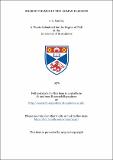Files in this item
Shared themes in the Roman elegists
Item metadata
| dc.contributor.advisor | Williams, G. W. | |
| dc.contributor.author | Yardley, John Charles | |
| dc.coverage.spatial | 398 p. | en_US |
| dc.date.accessioned | 2018-07-17T14:40:34Z | |
| dc.date.available | 2018-07-17T14:40:34Z | |
| dc.date.issued | 1976 | |
| dc.identifier.uri | https://hdl.handle.net/10023/15497 | |
| dc.description.abstract | The thesis is a detailed analysis of a selection of poems on similar themes by the Roman elegists in an attempt to estimate the originality of each poet in his treatment of each theme. The literary history of the themes prior to their occurrence in elegy is also considered. The study opens with a discussion of two "generic" themes, the paraclausithyron and the propempticon ("generic" here being used in the sense of classification in terms of the poems' content). It is demonstrated that while the elegists were certainly aware of the Greek komastic tradition and the many topoi associated with it, they are also distinctively Roman and individualistic in their handling of the theme of the exclusus amator (in particular in their employment of religious language in the address to the door). The section on the propempticon concerns Prop.18 and Ovid Am.2.11, and again it is argued that while both poets were aware of the generic conventions deriving from Greek literature, (those of the "schetliastic propempticon") they have made a traditional form serve their own purposes, Propertius "dramatising" the situation (Cyntbia at 1.8.26 is persuaded not to leave) and Ovid flippantly exaggerating and cleverly manipulating the topoi of the genre. The second chapter focusses on three themes which seem to have strong connections with comedy. The first is the rixa or lovers' quarrel in which violence is inflicted by the one party of the love affair on the other. The girl's violence is enjoyed by her lover because it is interpreted as an indication of her passionate love for him, while the lover's violence is a source of regret to him. Comic precedents for both attitudes are produced. Next under discussion is the soldier-rival, based on the character of the miles gloriosus of comedy but adapted to suit each elegist's purposes. The third comic theme is the affair with the ancilia, found in both Propertius and Tibullus but given a very different treatment by each of them. This is perhaps inspired by the comic situation in which the husband is suspected by his carping wife of having an affair with her ancilla. Three themes frequently occurring in Greek epigram are discussed in the third chapter. First under consideration is the figure of the irrisor amoris, the man who mocked love only to fall in love himself; variations on this theme by Tibullus (l,8.7lff. and 1.2.87ff.) and Propertius (l.9.lff.) are examined in detail. There follows an analysis of Tibullus 1.2.25ff., Prop.3.l6.11ff. and Ovid Am.l.6.13ff., adaptations of the epigrammatic motif of divine protection for the lover when he comes to his girl at night (but extended by Tibullus and Propertius to the claim that the lover enjoys divine protection at all times). The last epigrammatic theme discussed is that of the poet's attraction to several different types of girls/boys (Prop. 2.22A, 2.25.41ff; Tib.l.4.11ff; Ovid Am.2.4.2.10.). The fourth chapter is devoted to three illustrations of the elegist's obsequium his willingness to attend the girl in sickness, to hunt with her or go on a long journey with her. These, it is demonstrated by examples from Greek prose works on Friendship, are instances of the duties to be expected of a friend in Hellenistic Friendship Literature. These Freundschaftsdienste have been transformed by the elegists into examples of the lover's devotion. Chapter five is devoted to the themes of the girl's sickness (Prop. 2.28, (Tib.) 3.10, Ovid Am. 2.13), and her preoccupation with cosmetics (Prop.1.2, 2.l8c; Tib.l.8.9-16; Ovid Am.l.l4, Ars.3.101ff ., RA 343ff.). The former (which may derive ultimately from Callimachus) receives very different treatment from the three poets, though certain topoi recur in the poems, demonstrating a degree of inter-borrowing amongst the three. (The view that these similarities are due to the poems belonging to the genre soteria is countered in some detail). The treatment of the latter theme by Propertius may reveal comic influence, but its widespread occurrence in Greek literature of various genres precludes certainty. The conclusion attempts to draw together some of the threads of the discussion (which suggests throughout that while the elegists know and use Greek literature they are by no means servile imitators) by examining in detail Propertius 4.7 in which a number of different literary traditions are combined and used effectively by the poet. | en_US |
| dc.language.iso | en | en_US |
| dc.subject.lcc | PA6127.Y2 | en |
| dc.subject.lcsh | Epigrams, Latin | en |
| dc.title | Shared themes in the Roman elegists | en_US |
| dc.type | Thesis | en_US |
| dc.type.qualificationlevel | Doctoral | en_US |
| dc.type.qualificationname | PhD Doctor of Philosophy | en_US |
| dc.publisher.institution | The University of St Andrews | en_US |
This item appears in the following Collection(s)
Items in the St Andrews Research Repository are protected by copyright, with all rights reserved, unless otherwise indicated.

